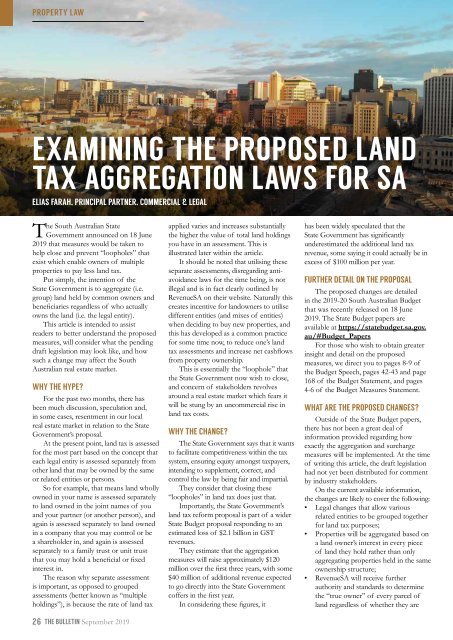LSB September 2019_Web
You also want an ePaper? Increase the reach of your titles
YUMPU automatically turns print PDFs into web optimized ePapers that Google loves.
PROPERTY LAW<br />
EXAMINING THE PROPOSED LAND<br />
TAX AGGREGATION LAWS FOR SA<br />
ELIAS FARAH, PRINCIPAL PARTNER, COMMERCIAL & LEGAL<br />
The South Australian State<br />
Government announced on 18 June<br />
<strong>2019</strong> that measures would be taken to<br />
help close and prevent “loopholes” that<br />
exist which enable owners of multiple<br />
properties to pay less land tax.<br />
Put simply, the intention of the<br />
State Government is to aggregate (i.e.<br />
group) land held by common owners and<br />
beneficiaries regardless of who actually<br />
owns the land (i.e. the legal entity).<br />
This article is intended to assist<br />
readers to better understand the proposed<br />
measures, will consider what the pending<br />
draft legislation may look like, and how<br />
such a change may affect the South<br />
Australian real estate market.<br />
WHY THE HYPE?<br />
For the past two months, there has<br />
been much discussion, speculation and,<br />
in some cases, resentment in our local<br />
real estate market in relation to the State<br />
Government’s proposal.<br />
At the present point, land tax is assessed<br />
for the most part based on the concept that<br />
each legal entity is assessed separately from<br />
other land that may be owned by the same<br />
or related entities or persons.<br />
So for example, that means land wholly<br />
owned in your name is assessed separately<br />
to land owned in the joint names of you<br />
and your partner (or another person), and<br />
again is assessed separately to land owned<br />
in a company that you may control or be<br />
a shareholder in, and again is assessed<br />
separately to a family trust or unit trust<br />
that you may hold a beneficial or fixed<br />
interest in.<br />
The reason why separate assessment<br />
is important, as opposed to grouped<br />
assessments (better known as “multiple<br />
holdings”), is because the rate of land tax<br />
26 THE BULLETIN <strong>September</strong> <strong>2019</strong><br />
applied varies and increases substantially<br />
the higher the value of total land holdings<br />
you have in an assessment. This is<br />
illustrated later within the article.<br />
It should be noted that utilising these<br />
separate assessments, disregarding antiavoidance<br />
laws for the time being, is not<br />
illegal and is in fact clearly outlined by<br />
RevenueSA on their website. Naturally this<br />
creates incentive for landowners to utilise<br />
different entities (and mixes of entities)<br />
when deciding to buy new properties, and<br />
this has developed as a common practice<br />
for some time now, to reduce one’s land<br />
tax assessments and increase net cashflows<br />
from property ownership.<br />
This is essentially the “loophole” that<br />
the State Government now wish to close,<br />
and concern of stakeholders revolves<br />
around a real estate market which fears it<br />
will be stung by an uncommercial rise in<br />
land tax costs.<br />
WHY THE CHANGE?<br />
The State Government says that it wants<br />
to facilitate competitiveness within the tax<br />
system, ensuring equity amongst taxpayers,<br />
intending to supplement, correct, and<br />
control the law by being fair and impartial.<br />
They consider that closing these<br />
“loopholes” in land tax does just that.<br />
Importantly, the State Government’s<br />
land tax reform proposal is part of a wider<br />
State Budget proposal responding to an<br />
estimated loss of $2.1 billion in GST<br />
revenues.<br />
They estimate that the aggregation<br />
measures will raise approximately $120<br />
million over the first three years, with some<br />
$40 million of additional revenue expected<br />
to go directly into the State Government<br />
coffers in the first year.<br />
In considering these figures, it<br />
has been widely speculated that the<br />
State Government has significantly<br />
underestimated the additional land tax<br />
revenue, some saying it could actually be in<br />
excess of $100 million per year.<br />
FURTHER DETAIL ON THE PROPOSAL<br />
The proposed changes are detailed<br />
in the <strong>2019</strong>-20 South Australian Budget<br />
that was recently released on 18 June<br />
<strong>2019</strong>. The State Budget papers are<br />
available at https://statebudget.sa.gov.<br />
au/#Budget_Papers<br />
For those who wish to obtain greater<br />
insight and detail on the proposed<br />
measures, we direct you to pages 8-9 of<br />
the Budget Speech, pages 42-43 and page<br />
168 of the Budget Statement, and pages<br />
4-6 of the Budget Measures Statement.<br />
WHAT ARE THE PROPOSED CHANGES?<br />
Outside of the State Budget papers,<br />
there has not been a great deal of<br />
information provided regarding how<br />
exactly the aggregation and surcharge<br />
measures will be implemented. At the time<br />
of writing this article, the draft legislation<br />
had not yet been distributed for comment<br />
by industry stakeholders.<br />
On the current available information,<br />
the changes are likely to cover the following:<br />
• Legal changes that allow various<br />
related entities to be grouped together<br />
for land tax purposes;<br />
• Properties will be aggregated based on<br />
a land owner’s interest in every piece<br />
of land they hold rather than only<br />
aggregating properties held in the same<br />
ownership structure;<br />
• RevenueSA will receive further<br />
authority and standards to determine<br />
the “true owner” of every parcel of<br />
land regardless of whether they are


















